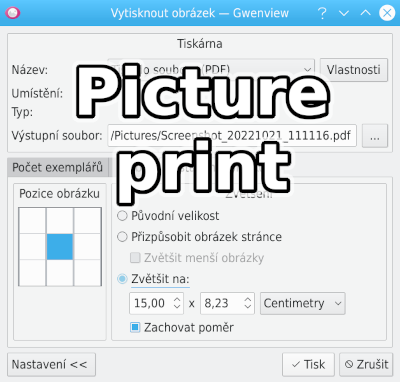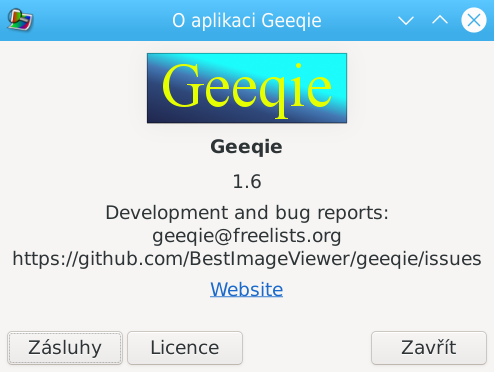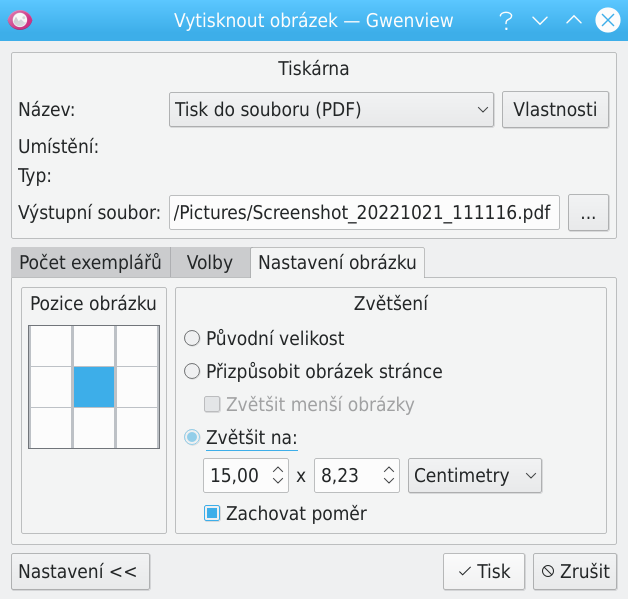Printing images in Linux
April 5, 2023Need to print more photos per page or print a photo in exact dimensions? Then this tutorial will show you how.

Even regular users of the GNU/Linux operating system need to print images.
And not just one image, but maybe multiple images per page or print an image so that it has the exact dimensions.
In Linux they can use various tools to do this, typically within a given image viewer.
Multiple images on one page
To easily print multiple images on one page, I use the Geeqie image viewer.

Geeqie is a free and open source graphical image viewer for Linux and other Unix-like operating systems. It is the successor to GQview, which was developed as part of the Xfce desktop environment. Geeqie supports many image formats, allows fast viewing and management of large numbers of photos, and also offers some advanced features such as EXIF metadata management, histograms, annotations, and much more.
Select multiple images put print and in the print parameters you can set how many images you want to put on one page.
You can see the print wizard and parameter settings in the following screenshot:

Exact dimensions of the printed image
I use Gwenview
to print an image when I need the exact dimensions of the printed image.
Gwenview is an image viewer for the Linux operating system, which allows users to view and edit photos and images. The program is part of the KDE desktop environment and provides a user-friendly interface that allows for quick browsing, view and edit photos. Some of the program's features include rotating images, zooming in and out, cropping, resizing, and displaying a histogram. Gwenview also allows users to create slideshows and view images in full-screen mode.
Select the image you want to print, give it a print, and in the print parameters you can set exactly what size you want the image to be printed at.
Or you can also stretch the image to full page.
You can see the details of what you can set in the following screenshot:

Here is a step by step video tutorial:
Console: multiple images per page
For bulk image editing, you can use tools from the ImageMagic
ImageMagick is an open-source software tool for editing and converting various types of image files. It allows users to create, edit, convert, display and distribute digital image data. ImageMagick supports more than 100 image file formats and can be used from the command line as well as using the API interface in C or C++. Thanks to the API and linking, you can use it as a library in many programming languages including, for example, PHP. Its features include resizing, cropping, rotation, color space conversion, preview creation, brightness and contrast adjustments, and many more. ImageMagick is available for a number of operating systems, including Linux, macOS and Windows.
To combine multiple images into one, use the montage command.
To combine four photos into a 2x2 format, use the following command:
montage -mode concatenate -tile 2x2 Screenshot_20220417_105436.png Screenshot_20220423_104859.png Screenshot_20220423_111014.png vysledny_obrazek.jpgThis command takes four images and combines them into one image/file named
resulting_image.jpg, which will have all four images on one page.
The "-tile 2x2" argument sets the arrangement of the input images into a single line, and the "-mode concatenate" argument concatenates the images with no space between them.
If you want to print more than four images per page, you can change the "-tile" argument to the desired number of columns and rows.
For an illustration of how to use the montage to command, see this video:
The ImageMagic package has even more commands in it, and the advantage of these console tools is that you can conveniently make bulk and automated changes.
Articles on a similar topic
Artificial Intelligence: dalle2, Chat GPT
Application design using UML using Umbrello
Nextcloud - data and applications in the cloud
GitLab - a tool for governance, versioning, CI/CD and project management
Newsletter
If you are interested in receiving occasional news by email.
You can register by filling in your email
news subscription.
+





